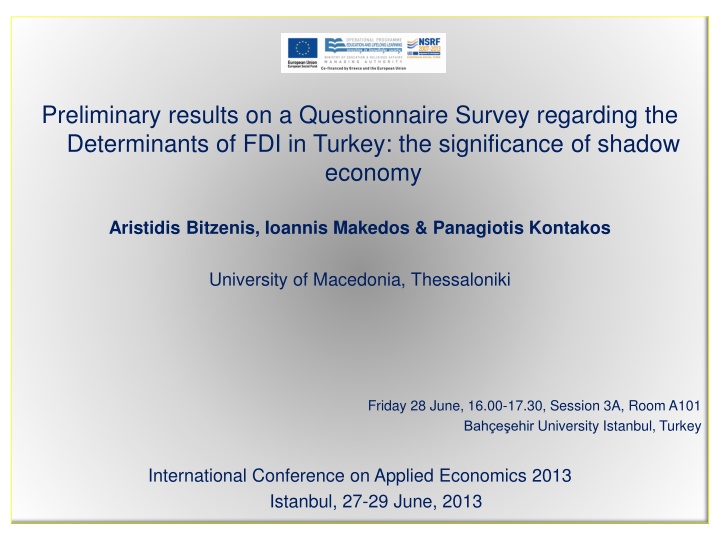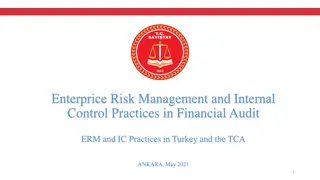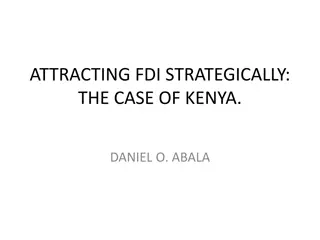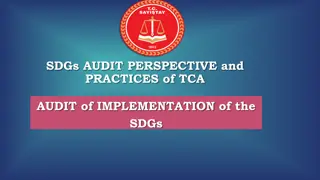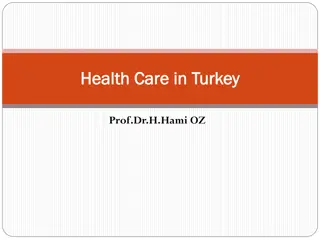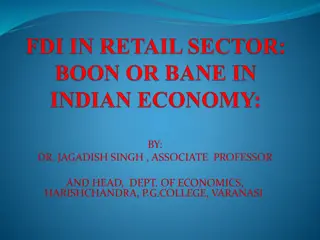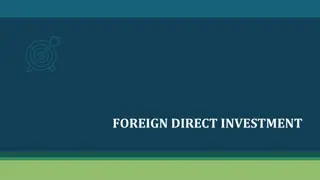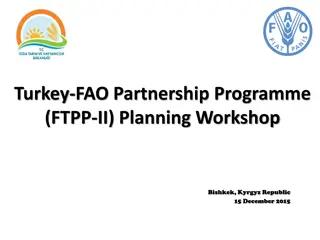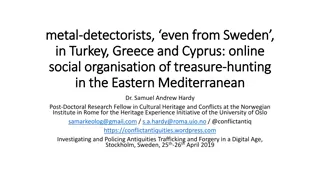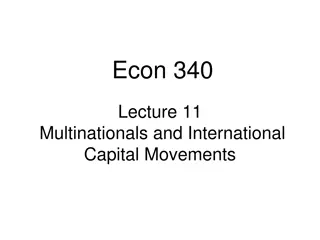Preliminary Results on Determinants of FDI in Turkey: Shadow Economy Significance
Presentation of preliminary results from a questionnaire survey analyzing the determinants of Foreign Direct Investment (FDI) in Turkey, focusing on the significance of the shadow economy. The study examines FDI trends, literature review synopsis, motives for investors, empirical evidence, and barriers in the Turkish banking sector.
Download Presentation

Please find below an Image/Link to download the presentation.
The content on the website is provided AS IS for your information and personal use only. It may not be sold, licensed, or shared on other websites without obtaining consent from the author.If you encounter any issues during the download, it is possible that the publisher has removed the file from their server.
You are allowed to download the files provided on this website for personal or commercial use, subject to the condition that they are used lawfully. All files are the property of their respective owners.
The content on the website is provided AS IS for your information and personal use only. It may not be sold, licensed, or shared on other websites without obtaining consent from the author.
E N D
Presentation Transcript
Preliminary results on a Questionnaire Survey regarding the Determinants of FDI in Turkey: the significance of shadow economy Aristidis Bitzenis, Ioannis Makedos & Panagiotis Kontakos University of Macedonia, Thessaloniki Friday 28 June, 16.00-17.30, Session 3A, Room A101 Bah e ehir University Istanbul, Turkey International Conference on Applied Economics 2013 Istanbul, 27-29 June, 2013
Agenda 1. Introduction: Motivation and Aim of this presentation 2. FDI trends in Turkey 3. A Synopsis of the Literature Review regarding determinants of FDI based on a questionnaire survey 4. Questionnaire Surveys / Interviews 5. Motives, Incentives and barriers for Foreign Investors in SEE, CEE and Turkey 6. Empirical evidence from cross-border acquisitions in the Turkish banking sector during the period 2001-2011 7. Preliminary results from our empirical evidence 2
1. Motivation and Aim of this presented paper Turkey has been a leading example of reform-driven growth acceleration in the period 2001 2013 During this period, cumulative FDI inflows (net) exceeded $137bn; FDI inflows in the financial intermediation sector have reinforced significantly this trend Although there is a significant increase in the volume of related academic literature, only a limited volume of academic research has been focused on questionnaire surveys Analyze the determinants of FDI in Turkey, through a questionnaire survey to be finalized during the summer 2013 Analyze the role of unofficial economy as an obstacle / barrier on discouraging future FDI inflows Present preliminary results from the motives of FDI in banking sector of Turkey during the decade 2001 2011 3
3. A Synopsis of Literature Review (determinants of FDI based on questionnaires surveys) Number of publications Publication period Methodology % a. Econometrics 48 32% 1988-2011 b. Questionnaire Surveys / Interviews 12 8% 1995-2011 c. Descriptive analysis 90 60% 1965-2011 Sector 17 11% 1998-2009 Historical 13 9% 1965-2010 EU / Customs Union 10 7% 1993-2009 Ligislation / Economic Liberalization / Promotive 10 7% 1993-2004 Comparative with Other Countries 5 3% 1997-2009 Comparison of Turkey with Other Countries 35 23% 1986-2011 Total 150 100% 1965-2011 Source: P. ntakos (2012) 4
2. Foreign direct investment trends in Turkey Significant improvement of inward FDI since 2002 Cummulative FDI inflows (net) in March 2013 exceeded $137 bn from $15 bn in 2002-1954. The number of companies with foreign capital participation reached 33,451 from 4,869 respectively FDI inflows in the Turkish financial intermediation sector are the main contributor. Also, acquisitions of real estate by foreigners are substantial and reached $22.6 bn in the period 2003-2013 (March) Up to March 2013, 152 countries had invested. In the period 2003- 2013 Netherlands ranked first with $15.8 bn, followed by USA with $8.2 bn. 5
4. Questionnaire Surveys / Interviews 12 relevant studies were found, which one (Coskun, 2001) compares the results of previous The majority papers is focused on the analysis & estimation importance of FDI determinants Turkey (Table 2) Puclication period Methodology Thamatology # Researchers of Questionnaire Survey / Interviews (107 companies) 2006-2010 (;) FDI Determinants 1 An l, . . (2011) 2001-2009 Interviews (12 companies) Sector 2 Pehlivanoglu (2010) three 2005 Questionnaire Survey (90 companies) FDI Determinants (location) 3 Berkoz and Turk (2009) surveys. 2006 Questionnaire Survey (52 companies) FDI Obstacles 4 Dumludagab (2009) of Sungur and Hellstrom (2006) 2005 Questionnaire Survey (11 companies) Derminants of Swedish FDI 5 Questionnaire Survey (# of companies n/a) 2004 (;) FDI Obstacles 6 Ok (2004) Loewendahl, E. and H. of the (2001) 2001 Interviews (30 companies) FDI Determinants / Obstacles 7 1978-1980, 1977, 1994 Synopsis of 3 previous surveys FDI Determinants 8 Coskun (2001) in Questionnaire Survey (# of companies n/a) 1994 FDI Determinants 9 Coskun (1996) 1978-1980 Questionnaire Survey (43 companies) FDI Determinants 10 Erdilek (1982) Sep 1993 - Feb 1994 Qustionnaire (150 companies in the form of oint ventures) FDI Determinants 11 Erden (1996) Questionnaire Survey / Interviews (# of companies n/a) 1977 FDI Determinants 12 Taslica (1995) Source: P. ntakos (2012) 6
5. Motives, Incentives and barriers for Foreign Investors in SEE, CEE and Turkey Bitzenis (2006, 2007) has conducted a comprehensive literature review of questionnaire surveys regarding the FDI determinants in CEE and SEE regions. Based on this review a Questionnaire has been constructed. The conceptual framework is derived from the Eclectic Paradigm, or the OLI approach, of Dunning (1993). Kontakos (2012) applied a similar approach for the FDI in the case of Turkish banking sector. These motives were also considered during the construction of the questionnaire (Table 1) Finally the significance of Turkish shadow / unofficial economy as an FDI barrier is explicitly analyzed in the questionnaire, particularly given its size, as discussed in other papers by Bitzenis, Schneider & Vlachos (2012) (Table 2) 7
Table 2: Shadow economy (GDP percentage). 2003 2004 2005 35,9 35,3 34,4 33,6 32,5 32,2 32,0 31,7 31,1 30,7 30,8 30,2 30,4 30,0 29,5 28,7 28,3 28,1 26,7 26,7 26,9 27,7 27,4 27,1 28,2 28,1 27,6 26,7 26,5 26,0 25,0 24,7 24,5 26,1 25,2 24,4 22,2 21,7 21,2 22,2 21,9 21,3 21,4 20,7 20,1 19,5 19,1 18,5 18,4 18,2 17,6 18,6 18,1 17,5 17,4 17,1 16,5 17,6 17,2 16,6 17,1 16,1 15,4 15,4 15,2 14,8 14,7 14,3 13,8 12,2 12,3 12,0 12,7 12,5 12,0 9,8 9,8 9,9 10,8 11,0 10,3 EU27 unweighted average 22,3 Non-EU European countries Croatia 32,3 Turkey 32,2 Norway 18,6 Switzerland 9,5 Highly developed non European OECD countries Canada 15,3 Australia 13,7 New Zealand 12,3 Japan 11,0 United States 8,5 Country/Year Bulgaria Romania Lithuania Estonia Latvia Cyprus Malta Poland Greece Slovenia Hungary Italy Portugal Spain Belgium Czech Republic Slovakia Sweden Denmark Finland Germany Ireland France United Kingdom Netherlands Luxembourg Austria 2006 34,0 31,4 30,6 29,6 29,0 27,9 27,2 26,8 26,2 25,8 24,4 23,2 20,1 20,2 19,2 18,1 17,3 16,2 15,4 15,3 15,0 13,4 12,4 11,1 10,9 10,0 9,7 20,8 2007 32,7 30,2 29,7 29,5 27,5 26,5 26,4 26,0 25,1 24,7 23,7 22,3 19,2 19,3 18,3 17,0 16,8 15,6 14,8 14,5 14,7 12,7 11,8 10,6 10,1 9,4 9,4 19,9 2008 32,1 29,4 29,1 29,0 26,5 26,0 25,8 25,3 24,3 24,0 23,0 21,4 18,7 18,4 17,5 16,6 16,0 14,9 13,9 13,8 14,2 12,2 11,1 10,1 9,6 8,5 8,1 19,3 2009 32,5 29,4 29,6 29,6 27,1 26,5 25,9 25,9 25,0 24,6 23,5 22,0 19,5 19,5 17,8 16,9 16,8 15,4 14,3 14,2 14,6 13,1 11,6 10,9 10,2 8,8 8,5 19,8 2010 32,6 29,8 29,7 29,3 27,3 26,2 26,0 25,4 25,4 24,3 23,3 21,8 19,2 19,4 17,4 16,7 16,4 15,0 14,0 14,0 13,9 13,0 11,3 10,7 10,0 8,4 8,2 19,5 2011 32,3 29,6 29,0 28,6 26,5 26,0 25,8 25,0 24,3 24,1 22,8 21,2 19,4 19,2 17,1 16,4 16,0 14,7 13,8 13,7 13,7 12,8 11,0 10,5 9,8 8,2 7,9 19,2 21,9 21,5 32,3 31,5 18,2 9,4 31,5 30,7 17,6 9,0 31,2 30,4 16,1 8,5 30,4 29,1 15,4 8,2 29,6 28,4 14,7 7,9 30,1 28,9 15,3 8,3 29,8 28,3 15,1 8,1 29,5 27,7 14,8 7,8 15,1 13,2 12,2 10,7 8,4 14,3 12,6 11,7 10,3 8,2 13,2 11,4 10,4 9,4 7,5 12,6 11,7 9,8 9,0 7,2 12,0 10,6 9,4 8,8 7,0 12,6 10,9 9,9 9,5 7,6 12,2 10,3 9,6 9,2 7,2 11,9 10,1 9,3 9,0 7,0 8
6. Empirical evidence from cross-border acquisitions in Turkish banking sector during 2001-11 The motives are exported from information reported in the bulletins of major financial institutions on the official date of a foreign investment transaction. Even if other factors may have been communicated to investors, the info contained in the official bulletins can be considered as more precise & constructive for their real motives (Table 1). The motives have been categorized in four categories: Location & country advantages, market advantages, efficiency advantages for the foreign bank investors and incentives from the Turkish government. The first three categories have been determined according to the frame of modified approach of selected example OLI of Dunning and the Internalization Theory. 9
6. Empirical evidence from cross-border acquisitions in Turkish banking sector during 2001-11 10
6. Empirical evidence from cross-border acquisitions in Turkish banking sector during 2001-11 11
8. Preliminary results from our empirical evidence CONCLUDING REMARKS The cultural proximity is obvious in the case of acquisition by National Commercial Bank (NCB) of Turkiye Finans According to host market advantages, the expected economic growth is characterized as a very important motive in the cases of National Bank of Greece, EFG Eurobank Ergasias, UniCredit and Banco Bilbao Vizcaya Argentaria (BBVA). Also, the political stability, Turkey was characterized by BBVA as a powerful democracy for more than 80 years and a model of country which is example for other countries . But between the banks which analyzed the political stability as a motive reported only from BBVA. 12
8. Preliminary results from our empirical evidence (cont.) CONCLUDING REMARKS The macroeconomic stability per se, or in terms of inflation, monetary stabilization, fiscal consolidation, volatility, was mentioned indirectly only from BBVA when it referred to the Turkey economy as one characterized by stable and disciplined economic policies . or exchange-rate The market size, in the logic of expected economic growth, usually defined in terms of GDP growth, was mentioned as a motive from the Greek investors and also from NBC and BBVA. The foreign bank efficiency advantages were considered by Citibank, NBG, Dexia, BBVA. 13
8. Preliminary results from empirical evidence (cont.) CONCLUDING REMARKS The deregulation of the Turkish financial system is not directly mentioned but can be implied as a significant factor, since the entrance of most of foreign bank investors coincided or followed the deregulation of the Turkish financial system in 2001 Overall, the results of the sample of the ten foreign banks of the study are overall in accordance with previous studies and analyzed in literature with the noticeable exception of prospect of Turkey s accession prospect to European Union, which doesn t appear explicitly relevant as an explanatory factor. 14
